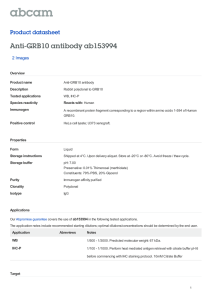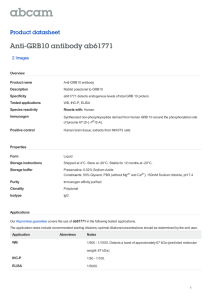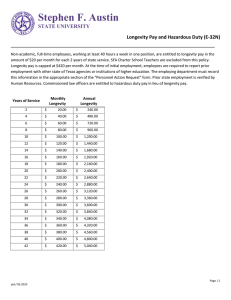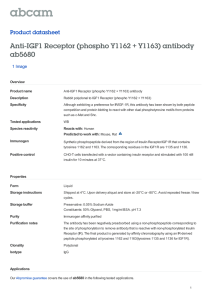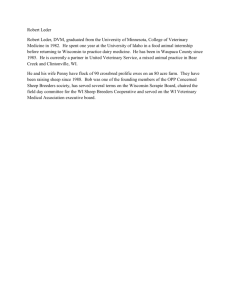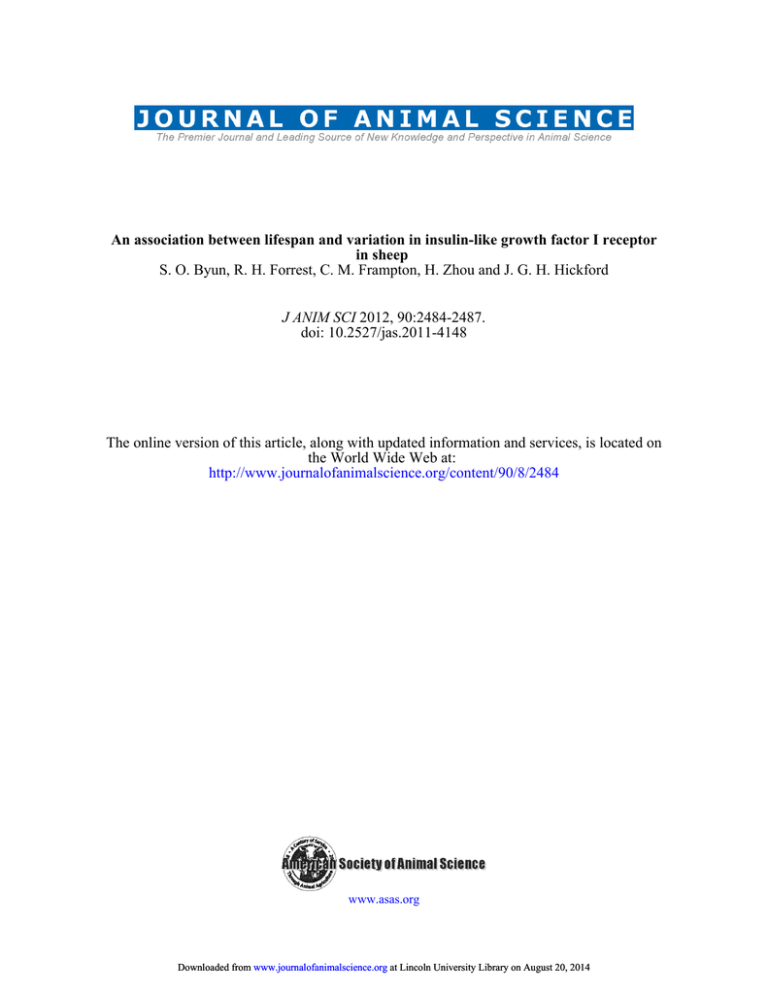
An association between lifespan and variation in insulin-like growth factor I receptor
in sheep
S. O. Byun, R. H. Forrest, C. M. Frampton, H. Zhou and J. G. H. Hickford
J ANIM SCI 2012, 90:2484-2487.
doi: 10.2527/jas.2011-4148
The online version of this article, along with updated information and services, is located on
the World Wide Web at:
http://www.journalofanimalscience.org/content/90/8/2484
www.asas.org
Downloaded from www.journalofanimalscience.org at Lincoln University Library on August 20, 2014
An association between lifespan and variation
in insulin-like growth factor I receptor in sheep1
S. O. Byun,* R. H. Forrest,† C. M. Frampton,‡ H. Zhou,* and J. G. H. Hickford*2
*Faculty of Agriculture and Life Sciences, Lincoln University, Canterbury 7647,
New Zealand; †Faculty of Health and Sport Sciences, Eastern Institute of Technology, Napier,
New Zealand; and ‡Christchurch School of Medicine and Health Sciences, Christchurch, New Zealand
ABSTRACT: Longevity in livestock is a valuable trait.
When productive animals live longer, fewer replacement
animals need to be raised. However, selection for
longevity is not commonly the focus of breeding
programs as direct selection for long-lived breeding stock
is virtually impossible until late in the reproductive life of
the animal. Additionally the underlying genetic factors
or genes associated with longevity are either not known,
or not well understood. In humans, there is evidence
that IGF 1 receptor (IGF1R) is involved in longevity.
Polymorphism in the IGF1R gene has been associated
with longevity in a number of species. Recently, 3 alleles
of ovine IGF1R were identified, but no analysis of the
effect of IGF1R variation on sheep longevity has been
reported. In this study, associations between ovine IGF1R
variation, longevity and fertility were investigated.
Polymerase chain reaction-single strand conformational
polymorphism (PCR-SSCP) was used to type IGF1R
variation in 1,716 New Zealand sheep belonging to 6
breeds and 36 flocks. Ovine IGF1R C was associated with
age when adjusting for flock (present 5.5 ± 0.2 yr, absent
5.0 ± 0.1 yr, P = 0.02). A general linear mixed effects
model suggested an association (P = 0.06) between
age and genotype, when correcting for flock. Pairwise
comparison (least significant difference) of specific
genotypes revealed the difference to be between AA (5.0
± 0.1 yr) and AC (5.6 ± 0.2 yr, P = 0.02). A weak negative
Pearson correlation between fertility and longevity traits
was observed (r = -0.25, P < 0.01). The finding of an
association between variation in IGF1R and lifespan in
sheep may be useful in prolonging the lifespan of sheep.
Key words: fertility, insulin-like growth factor 1, longevity,
polymerase chain reaction-single strand conformational polymorphism, sheep
© 2012 American Society of Animal Science. All rights reserved.
INTRODUCTION
In sheep production systems the cost of producing and maintaining replacement breeding ewes can be
very high. What is more, those replacement ewes produce no output, other than wool (in wool breeds), until
they reach sexual maturity, at which stage they may
still be infertile. Consequently, strategies that might increase the longevity of breeding ewes may be valuable
to sheep production.
1 This work was financially supported by the Gene-Marker Laboratory,
Lincoln University, New Zealand. Thirty-six New Zealand farmers made
their flocks and flock records available for this research.
2 Corresponding author: jon.hickford@lincoln.ac.nz
Received August 8, 2011.
Accepted October 16, 2011.
J. Anim. Sci. 2012.90:2484–2487
doi:10.2527/jas2011-4148
In many species, the IGF1 receptor (IGF1R) has
been implicated in regulating lifespan. Polymorphism
in the IGF1R gene has been associated with longevity
in species as diverse as nematodes (Braekman and
Vanfleteren, 2007), fruit flies (Paaby and Schmidt, 2009),
mice (Liang et al., 2003) and humans (Suh et al., 2008). A
gene knockout model in mice (Holzenberger et al. 2003)
revealed that heterozygous knockout mice (because null
mutants are not viable) lived on average 26% longer
than their wild-type littermates. Little is known about
ovine IGF1R or IGF1R and whether it affects longevity.
The mammalian IGF is part of a complex metabolic
system which mediates a wide range of biological
activities including carbohydrate and lipid metabolism,
cell growth, cell differentiation and aging (Richardson et
al., 2004). Within the IGF system, IGF1R is responsible
for initiating the IGF signaling pathway by interacting
2484
Downloaded from www.journalofanimalscience.org at Lincoln University Library on August 20, 2014
An association between life-span and variation in IGF1R in sheep
with insulin or IGF1. Structurally, IGF1R is composed
of 2 extracellular α subunits and 2 transmembrane β
subunits. The α subunits contain a cysteine-rich region
that is involved in ligand binding, whereas the β subunits
have a tyrosine kinase domain in their cytoplasmic region
that is involved in signal transduction (Adams et al., 2000,
Denley et al., 2005). Variation in the α and β subunits of
IGF1R may affect its interaction with IGF1 or insulin, and
result in alteration to signaling pathways.
A previous study has reported 3 allelic variants of
ovine IGF1R. This variation occurred in a fragment
of intron 2 and exon 3 (Byun et al., 2008), the latter
encoding part of the α subunit of the receptor protein. In
this study, associations between ovine IGF1R variation,
longevity and fertility were investigated.
2485
General linear mixed effects models (GLMM)
were used to assess the effect of the presence of each of
the IGF1R alleles on longevity and fertility, while correcting for flock (fitted as a random factor), which corrected for environmental, breed and management effects as each farm only had 1 breed. The GLMM were
also used to explore the effects of the more common
IGF1R genotypes (frequency ≥ 10%) on longevity and
fertility. Where significant or if tending towards significance, these were further explored using pairwise
comparisons (least significant difference).
Pearson χ2 analysis was used to ascertain whether or
not IGF1R genotype frequencies differed between older
and younger ewes.
RESULTS
MATERIALS AND METHODS
The Lincoln University Animal Ethics Committee
approved the collection of blood from animals used in
this study.
Animals and Data Collection
In total, 1,716 New Zealand [Romney (n = 340,
Corriedale (n = 318), Merino (n = 322), Polwarth (n =
127), Kelso (n = 173) and Coopworth (n = 436)] ewes
from 36 different commercial breeding flocks were
investigated. Blood samples were collected onto FTA
cards (Whatman BioScience, Middlesex, UK). Sheep
age was recorded in years as birth date data were not
available. Fecundity records were available for many
of the ewes with these data typically being obtained
from Sheep Improvement Limited (SIL), the New
Zealand national flock recoding system. Overall there
were 766 young or replacement ewes (around 18 mo
old) and 950 older ewes (3 to 16 yr of age). Fecundity
data (number of lambs born each year) were available
for 650 of the older ewes.
Genotype of Ovine IGF1R
For each sample, a single FTA card punch was placed
in a 200-μL tube and the genomic DNA purified using
a 2-step washing procedure as described by Zhou et al.
(2006). The ovine IGF1R gene was genotyped using
PCR-single strand conformational polymorphism (PCRSSCP) as described previously (Byun et al., 2008).
Statistical Analyses
Data were analyzed using SPSS version 15 (SPSS
Science Inc., Chicago, IL), with a significance level of
α = 0.05.
The average age of the ewes was 5.35 yr (ranged
from 2 to 16 yr) and the average number of lambs born
per year, per ewe, ranged from 0.71 to 3.00. The genotype frequencies for the 3 alleles of ovine IGF1 is shown
in Table 1. These frequencies were significantly different between the older ewes and the 18 mo old replacement ewes (χ2, P = 0.01).
The presence/absence of IGF1R C was found to be
associated with age (Table 2), with ewes that possessed
IGF1R C having a mean age of 5.5 ± 0.2 yr whereas
ewes that did not possess the allele having a mean age
of 5.0 ± 0.1 yr (P = 0.02). To assess the effect of IGF1R
genotype on lifespan, only the common genotypes AA,
AB and AC were included (Table 3) as genotypes BB (n =
8), BC (n = 13) and CC (n = 23) were rare. The GLMM
suggested an association, although not significant (P =
0.06), between age and genotype. A pairwise comparison
revealed the difference to be between AA (5.0 ± 0.1 yr)
and AC (5.6 ± 0.2 yr, P = 0.02).
The presence/absence of IGF1R variants and
IGF1R genotype GLMM for fertility did not detect any
associations (data not shown). A weak negative Pearson
correlation between fertility and longevity traits was
observed (r = -0.25, P < 0.01).
DISCUSSION
This is the first report suggesting a relationship
between variation in IGF1R and lifespan in sheep. In
this study the presence of the C allele of ovine IGF1R
was associated with ewe longevity and therefore
may affect the ovine IGF1 signaling pathway. Ovine
IGF1R C has a synonymous substitution in exon
3 (Byun et al., 2008), compared with the A and B
variants. Whereas this substitution does not result
in an AA change, it may nevertheless be linked to
other nucleotide changes in the coding regions, or to
Downloaded from www.journalofanimalscience.org at Lincoln University Library on August 20, 2014
2486
Byun et al.
Table 1. The IGF1 genotype frequencies in older (3 to
16 yr) and younger (2 yr) ewe groups
AA
Older
Younger
Total
Frequencies
AB
Genotype
AC
BB
BC
694
90
140
73.1% 9.5% 14.7%
596
78
73
77.8% 10.2% 9.5%
1292
168
213
75.2% 9.8% 12.4%
CC
Table 3. Association of the ovine IGF1 genotype with
ewe age in years
Genotype
No.
1292
168
212
Unadjusted model
5.2 ± 0.1a
5.3 ± 0.3a
6.3 ± 0.2b
Flock adjusted model
5.0 ± 0.1a
5.1 ± 0.3ab
5.6 ± 0.2b
(P < 0.01)
(P = 0.06)
Different superscripts indicate the pair of means was significantly different (P < 0.05) in pairwise comparisons (least significant difference)
a,b
Variant
A
Present
Absent
No.
1671
45
B
Present
Absent
189
1527
C
Present
Absent
249
1467
All
2
9
15
950
0.2% 0.9% 1.6% 100%
6
4
9
766
0.8% 0.5% 1.2% 100%
8
13
24
1716
0.5% 0.8% 1.4% 100%
sequence variation elsewhere in the gene. This may
affect gene expression or the function or both of
IGF1R and hence affect sheep longevity.
The finding of an association between variation in
IGF1R and lifespan in sheep is consistent with reports
in other species. Insulin-like growth factor1 has been
implicated in attenuation of longevity from lower
animals to mammals (Sepp-Lorenzino, 1998; Babrieri
et al. 2003; Richardson et al., 2004; ). Genetic mutant
(Liang et al., 2003) and caloric restricted (Masoro,
2005) rodent models have revealed that a reduction in
insulin/IGF1 signaling and/or a reduction in plasma
concentrations of insulin/IGF1 appears to be correlated
with increased longevity and extended aging.
The IGF1R is a key regulator of IGF 1 signaling
and is activated by the binding of either IGF1 or
insulin (Adams et al., 2000). Accordingly mutations in
IGF1R may alter the function of the receptor and result
in variation in IGF1R signaling, thereby increasing
lifespan. This is supported by a rodent model in which
heterozygous IGF1R knockout mice (null mutants are not
viable) live on average 26% longer than their wildtype
litter mates (Holzenberger et al. 2003). Furthermore, in
humans, certain IGF1R variants have been associated
with altered IGF1 signaling and increased lifespan
(Bonafè et al., 2003; Suh et al., 2008).
It is interesting to speculate why the variation
reported here in IGF1R occurs or persists or both in the
population of sheep studied. These sheep were selected
for analysis and hence a population-based analysis of
Hardy-Weinberg equilibrium would be inappropriate.
However, the results suggest that despite IGF1R C
being more commonly found in older ewes, the IGF1R
A variant is proportionally more common in the younger
AA
AB
AC
Table 2. Association of the ovine IGF1 variants with
ewe age in years
Unadjusted
model
5.3 ± 0.0
5.7 ± 0.2
(P = 0.51)
5.3 ± 0.2
5.4 ± 0.1
(P = 0.81)
6.2 ± 0.2
5.2 ± 0.1
(P < 0.01)
Flock-adjusted
model
5.1 ± 0.1
5.0 ± 0.5
(P = 0.82)
5.6 ± 0.2
5.1 ± 0.1
(P = 0.90)
5.5 ± 0.2
5.0 ± 0.1
(P = 0.02)
ewe population. The A variant is also the most common
variant in the ewes studied, suggesting that A confers
some advantage for ewes, especially younger ewes.
The knockout mouse models suggest why this may
be, as heterozygous knockout mice were typically
slower growing that their non-transgenic litter-mates
(Holzenberger et al. 2003). It could be speculated then
that the C variant is associated with slower growth
rates in sheep, which would be an anathema to sheep
production, and the IGF1R A variant is associated
with faster growth rates, although this would require
further study.
The lifespan of a domestic ewe reflects a number
of factors including health, reproductive performance
and their productivity. If any of these factors is
compromised then the ewe is likely to be culled, thus
having an artificially shorter lifespan. According to the
‘trade-off’ theory, enhanced longevity is achieved at the
expense of reduced fertility (Holliday, 2006). Hence
any gene impacting on longevity may negatively impact
on reproductive performance. However, longevity in
livestock also reflects the ability of animal to maintain
health and performance, and which would also impact
on increasing a number of offspring during their life
time. Thus any gene associated with lifespan in female
breeding stock would not be expected to be associated
with a large cost to fertility.
In this study a weak negative correlation was
observed between longevity and fertility. Interestingly,
and in contrast to the findings reported here, the
heterozygous IGF1R knockout mice had normal energy
metabolism, nutrient uptake, activity and fertility
(Holzenberger et al. 2003).
As older ewes are culled and require replacement,
some or all new-born female lambs are kept until
they reach reproductive maturity. During this time,
replacement ewes produce no output, other than wool
(in wool breeds), and once sexual maturity is achieved
they may be infertile. Thus the cost of producing and
maintaining replacement breeding ewes can be very high,
and maintenance of older ewes beneficial. Exploiting the
Downloaded from www.journalofanimalscience.org at Lincoln University Library on August 20, 2014
An association between life-span and variation in IGF1R in sheep
variation in the IGF1R as a gene marker for longevity
may be valuable to sheep production.
LITERATURE CITED
Adams, T. E., V. C. Epa, T. P. J. Garrett, and C. W. Ward. 2000.
Structure and function of the type 1 insulin-like growth factor
receptor. Cell. Mol. Life Sci. 57:1050–1093.
Barbieri, M., M. Bonafè, C. Franceschi, and G. Pasolisso. 2003.
Insulin/IGF-1-signaling pathway: an evolutionarily conserved
mechanism of longevity from yeast to humans. Am. J. Physiol.
Endocrinol. Metab. 285:E1064–1071.
Bonafè, M., M. Barbieri, F. Marcheqiani, F. Olivieri, E. Ragno, C.
Giampieri, E. Muqianesi, M. Centurelli, C. Franceschi, and G.
Paolisso. 2003. Polymorphic variants of insulin-like growth
factor 1(IGF-1) receptor and phosphoinositide 3-kinase genes
affect IGF-1 plasma levels and human longevity: cues for an
evolutionarily conserved mechanism of life span control. J.
Clin. Endocrinol. Metab. 88:3299–3304.
Braekman, B. P., and J. R. Vanfleteren. 2007. Genetic control of
longevity in C. elegans. Exp. Gerontol. 42:90–98.
Byun, S. O., H. Zhou, and J. G. Hickford. 2008. Polymorphism of the
ovine insulin-like growth factor 1 receptor (IGF1R) gene. Mol.
Cell. Probes 22:131–132.
Denley, A., L. J. Cosqrove, G. W. Booker, J. C. Wallace, and B.
E. Forbes. 2005. Molecular interactions of the IGF system.
Cytokine Growth Factor Rev. 16:421–439.
2487
Holliday, R. 2006. Aging is no longer an unsolved problem in biology.
Ann. N. Y. Acad. Sci. 1067:1–9.
Holzenberger, M., J. Dupont, B. Ducos, P. Leneuve, A. Geloen, P.
C. Even, P. Cervera, and Y. Le Bouc. 2003. IGF-1 receptor
regulates life span and resistance to oxidative stress in mice.
Nature 421:182–186.
Liang, H., E. J. Masoro, J. F. Nelson, R. Strong, C. A. McMahan,
and A. Richardson. 2003. Genetic mouse models of extended
lifespan. Exp. Gerontol. 38:1353–1364.
Masoro, E. J. 2005. Overview of caloric restriction and ageing. Mech.
Ageing Dev. 126:913–922.
Paaby, A. B., and P. S Schmidt. 2009. Dissecting the genetics of
longevity in Drosophila melanogaster. Fly 3:1.
Richardson, A., F. Liu, M. L. Adamo, H. Van Remmen, and J. F.
Nelson. 2004. The role of insulin and insulin-like growth factor-1
in mammalian ageing. Best Pract. Res. Clin. Endocrinol. Metab.
18:393–406.
Sepp-Lorenzino, L. 1998. Structure and function of the insulin-like
growth factor I receptor. Breast Cancer Res. Treat. 47:235–253.
Suh, Y., G. Atzmon, M. O. Cho, D. Hwang, B. Liu, D. J. Leahy, N.
Barzilai, and P. Cohen. 2008. Functionally significant insulinlike growth factor 1 receptor mutations in centenarians. Proc.
Natl. Acad. Sci. U.S.A. 105:3438–3442.
Zhou, H., J. G. H. Hickford, and Q. Fang. 2006. A two-step procedure
for extracting genomic DNA from dried blood spots on filter
paper for polymerase chain reaction amplification. Anal. Bioch.
354:159–161.
Downloaded from www.journalofanimalscience.org at Lincoln University Library on August 20, 2014
References
This article cites 15 articles, 2 of which you can access for free at:
http://www.journalofanimalscience.org/content/90/8/2484#BIBL
Downloaded from www.journalofanimalscience.org at Lincoln University Library on August 20, 2014

